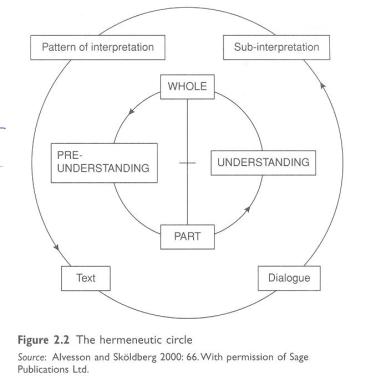Pride may not be as important but prejudice certainly impacts the way we read. Stanley Baran and Dennis Davis describe hermeneutics as “the study of understanding, especially through the systematic interpretation of actions or texts” (Baran & Davis, 2011, p. 13). Whether readers acknowledge it or not, they begin reading a book with preconceived notions; a reader may begin reading Jane Austen’s Pride and Prejudice with assumptions about the Victorian era or about Jane Austen’s station in life. Readers may have heard the reputation of Austen’s Mr. Darcy and think they know about “characters like him”—and perhaps they do. Readers may have watched a film adaptation of Austen’s novel or heard criticism of her canon of work. Even if a reader has never heard of Austen or Pride and Prejudice when they select any book they develop a cursory understanding of the book based on the cover, length, or even just the idea of a novel.
Klaus Bruhn Jensen (2013) suggests that “any understanding requires a pre-understanding – a ‘prejudice’ in the neutral sense” (p.22). The hermeneutic circle discusses how understanding is realized, aka how readers understand a book. “Throughout the activity of reading, people perform minimal or sub-interpretations, which may realign their frames of interpretation. In doing so, they enter into a ‘dialogue’ with the text and, by extension, with other minds, past as well as present” (Jensen, 2013, p.22). The hermeneutic circle elaborates on the process of understanding literature. Readers enter into a book with a pre-understanding or “prejudice” and the ongoing dialogue with the text, which is also known as reception theory—how an audience receives the messages, changes the reader’s perceptions and understanding of the book.
The process of reading needs to be complete for a reader to understand a book because the dialogue between the reader and book impacts interpretation until the reading process is complete (and sometimes even after the reading is complete the reader reflects on the book and the understanding process continues). Additionally, “the meaning of a message is the sum of its parts, so that communication might be studied by breaking it down into its constituent elements. Hermeneutics suggests that the very process of both reading and analyzing a text is incremental and creative – readers gradually work out their categories of understanding in order to arrive at a coherent interpretation” (Jensen, 2013, p.21). In the hermeneutic circle, “part” and “whole” are identified on a spectrum because part of a book in isolation will be understood differently than the same part in conjunction with the entire work.
Hermeneutics is not simply something applied to reading as an afterthought, “hermeneutics developed out of the practice of reading and understanding written texts” (Jensen, 2013, p.21). Studying hermeneutic circle shines insight into the reading process and how texts are interpreted. “The hermeneutic circle, central to the interpretation theory, preaches that an explication of a text occurs only after a prior understanding of it” (Macdonald & Macdonald, 2003, p.76). Arguably this is why women regard the iconic love interest, Mr. Darcy, as a romantic figure, for if reading Pride and Prejudice without a preconceived notion of Mr. Darcy’s appeal perhaps his unfavourable character traits such as standoffishness, condescension, and (ironically) prejudice may not seem so romantic or appealing. Conversely, the inherent desirability of Mr. Darcy could exist not because of pre-understanding of the book but of pre-understanding of what is desirable. In any event, pre-understanding affects the interpretation and understanding of Pride and Prejudice, as it does the reading of anything based on the model of understanding outlined by hermeneutics.
Citations
Baran, S. J., & Davis, D. K. (2011). Mass communication theory: foundations, ferment, and future (6th ed.). Boston, MA: Wadsworth.
Jensen, K. B. (Ed.). (2013). A handbook of media and communication research: qualitative and quantitative methodologies. Routledge.
Macdonald, G., & Macdonald, A. (Eds.). (2003). Jane Austen on screen. Cambridge University Press.
